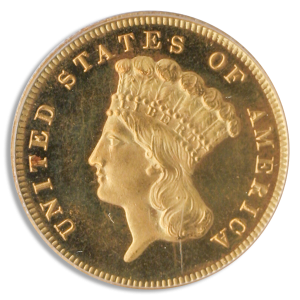The Intriguing Numismatic Theory Behind This Coin
Posted on — 1 CommentAmericans had mixed feelings about the $3 gold piece. In the late 1880’s the $3 Indian Princess Head was worth well over a day’s pay.
well over a day’s pay.
What’s more – it carried an odd number.
It turns out that very few people wanted to use coin which did not fit into the already accepted decimal calculations. Even though it was not heavily used in circulation – the $3 gold piece instantly captured the attention of coin collectors.
Numismatists began avidly seeking out and saving the intriguing $3 Indian Princess gold coin as early as 1879.
So why did the U.S. Mint decide to produce a $3 gold coin – especially since they already had a gold quarter eagle worth $2.50?
The surprising theory behind the origin of this coin is an unlikely culprit: a U.S. postage stamp. When this coin was minted a U.S. postage stamp cost 3 cents.
Numismatists believed that the sole purpose for creating the $3 coin was to create a convenient way for businesses to purchase 100 stamps in a single transaction.
Every U.S. coin denomination has a number of rarities. Yet, the $3 Indian Princess Head, minted from 1854-1889, is packed with so many low-mintage dates that the entire series is considered rare.
In 1880, for example, only 1,000 were minted. In 1881 only 500 were minted. And in 1882, only 1,500 were minted. Plus, many were lost to the melting pot in the 1930’s, reducing the number of survivors available today.
Many consider the $3 Indian Princess the most beautiful gold coin struck in the 19th century. See the rich and warm patina that comes with a 141 year old masterpiece here.
Designed by the U.S. Mint’s chief engraver, James B. Longacre, the $3 gold coin was the first time he had been given the freedom to create a design of his own. Longacre wrote that, previous to the $3 gold coin, he had been directed to adapt Roman or Greek features into U.S. coins. For the $3 gold coin, Longacre was determined to create something uniquely American.
“From the copper shores of Lake Superior to the silver mountains of Potosi, from the Ojibwa to the Araucanian, the feathered tiara is a characteristic of the primitiveness of our hemisphere as the turban is of the Asiatic,” Longacre wrote.
He was inspired to feature an “Indian Princess” on the obverse of this stunning coin. A lustrous orange-gold color, the coin shows a gorgeous Indian Princess adorned with a feathered headdress, with the words UNITED STATES OF AMERICA encircling her. On the reverse, the date and denomination is surrounded by an agricultural wreath celebrating corn, tobacco, cotton, and wheat.
Rare Coin Market Update
This summer we are seeing huge numismatic demand and extremely low inventory levels, which is contributing to rising prices.
In June 2021, the Rare Coin Values Index hit a new all-time record high of 434.28. (The Rare Coin Value Index is based on the combined percent change in retail prices for 87 rare United States coins and is updated monthly.)
Numismatic rarities that come onto the market can sell in a matter of days due to the limited supply and strong investor interest. Long-time numismatic investors are holding and expanding their collections when they can.
Investors are seeking opportunities to diversify their portfolios and protect and grow their wealth through tangible assets like rare coins – that are a non-correlated asset to the stock market. If there is a coin that you seek, call us today. We are often able to source even hard-to-find coins due to our deep connections inside the numismatic community.
Want to read more? Subscribe to the Blanchard Newsletter and get our tales from the vault, our favorite stories from around the world and the latest tangible assets news delivered to your inbox weekly.
1 thought on “The Intriguing Numismatic Theory Behind This Coin”
Comments are closed.








I love this stuff